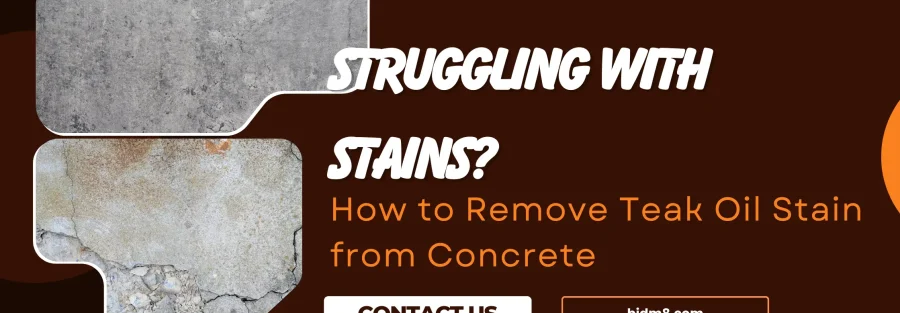Struggling with Stains? How to Remove Teak Oil Stain from Concrete
Discovering a teak oil stain on your concrete floor can be frustrating, but learning how to remove teak oil stain from concrete doesn’t have to be a nightmare. Imagine you’re in the middle of a woodworking project, carefully applying teak oil to a beautiful piece of furniture, when suddenly – a splash lands on your pristine concrete floor. The moment of panic sets in, but take a deep breath. With the right knowledge and approach, those stubborn teak oil stains can be conquered effectively and efficiently.

Understanding Teak Oil Stains on Concrete
Teak oil is notorious for leaving behind challenging stains that can mar the appearance of concrete surfaces. These persistent marks are more than just an aesthetic issue – they can potentially create fine, spider-web-like cracks that compromise the smooth surface of your concrete. The chemistry behind these stains is complex, as teak oil penetrates porous surfaces quickly, making immediate action crucial.
Types of Teak Oil Stains
To better understand the challenge, let’s break down the different types of teak oil stains you might encounter:
| Stain Type | Characteristics | Difficulty Level |
|---|---|---|
| Fresh Spill | Wet, newly applied | Easy to Remove |
| Set-In Stain | Dried, partially absorbed | Moderate Difficulty |
| Old Stain | Deep penetration, long-standing | Highly Challenging |
Immediate Action: First Steps to Remove Teak Oil Stains
1. Blot, Don’t Spread
The moment you notice a teak oil spill, your reaction is critical. Professional cleaners and restoration experts agree that the first line of defense is proper blotting technique.
When dealing with a fresh spill:
- Choose clean, highly absorbent rags or paper towels
- Gently blot the area with a light, dabbing motion
- Focus on lifting the oil rather than rubbing it into the concrete
- Work from the edges of the stain toward the center to prevent spreading
The science behind this technique is simple yet effective. By blotting, you’re using the absorbent material to draw out the oil before it can fully penetrate the concrete’s porous surface. Each gentle dab helps extract more of the oil, minimizing potential long-term damage.
2. Absorption Techniques
Sometimes, you need extra help to tackle those stubborn oil spills. Absorption materials can be your best friend in these situations.
Recommended absorption methods include:
- Sprinkling high-quality cat litter or specialized clay-based absorbents
- Using baking soda or cornstarch for their exceptional oil-absorbing properties
- Applying commercial oil-absorbing granules designed for concrete
- Letting the absorbent material sit for 15-30 minutes to maximum effect
These materials work by creating a barrier that pulls oil away from the concrete surface. The porous nature of substances like cat litter and baking soda allows them to trap and lift oil molecules effectively.
Comprehensive Cleaning Methods
Method 1: Soap and Water Approach
For recent stains that have slightly set, a simple soap solution can work wonders. Professional cleaners often recommend this as the first line of defense for light stains. The surfactants in dish soap help break down oil molecules, making them easier to remove from the concrete surface.
Detailed steps include:
- Mix a solution of warm water and grease-cutting dish soap
- Ensure the water is warm but not hot, as extreme temperatures can set the stain
- Pour the solution directly onto the stained area
- Allow the solution to penetrate for 5-10 minutes
- Use a stiff-bristled brush with moderate pressure
- Rinse thoroughly with clean water
- Repeat if necessary
Method 2: Baking Soda Power
Baking soda is a miracle worker when it comes to oil stain removal. Its alkaline nature and incredible absorption properties make it a go-to solution for many home maintenance challenges.
The comprehensive approach involves:
- Generously covering the entire stained area with baking soda
- Creating a thick, even layer that completely masks the oil stain
- Allowing sufficient time for absorption (30-60 minutes recommended)
- Using plastic wrap to prevent wind dispersion for outdoor surfaces
- Carefully sweeping or vacuuming the dried baking soda
- Inspecting the area and repeating if any oil residue remains
Cleaning Efficacy Comparison
| Cleaning Method | Effectiveness | Ease of Use | Environmental Impact |
|---|---|---|---|
| Soap and Water | Moderate | Very Easy | Low Impact |
| Baking Soda | High | Easy | Environmentally Friendly |
| Mineral Spirits | Very High | Moderate | Chemical Intensive |
Beyond the Basics: Advanced Removal Techniques
While the methods described are effective, some situations require more advanced approaches. Professional restoration experts often employ specialized techniques for deeply embedded stains, including:
- Steam cleaning with specialized concrete cleaning attachments
- Industrial-grade degreasers
- Poultice treatments that draw out stubborn oil molecules
Safety and Precautions
Always prioritize safety when dealing with oil stains and cleaning chemicals:
- Work in a well-ventilated area
- Wear protective gloves and eye protection
- Use respiratory protection when working with strong cleaning agents
- Keep the area clear of children and pets
- Properly dispose of used cleaning materials
Final Insights
Removing a teak oil stain from concrete is a process that requires patience, the right tools, and a systematic approach. Each stain is unique, and what works for one might require slight modification for another. The key is to act quickly, be thorough, and don’t get discouraged if the first attempt isn’t completely successful.
Remember, prevention is always better than cure. Consider using drop cloths, working in controlled environments, and applying concrete sealants to protect your surfaces from future oil-related mishaps.

